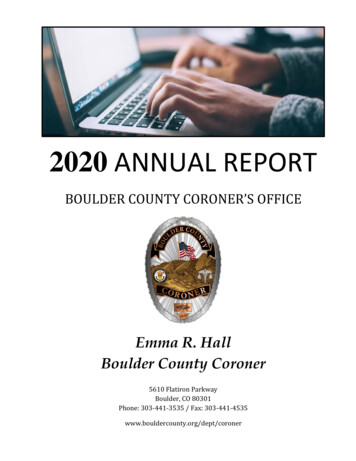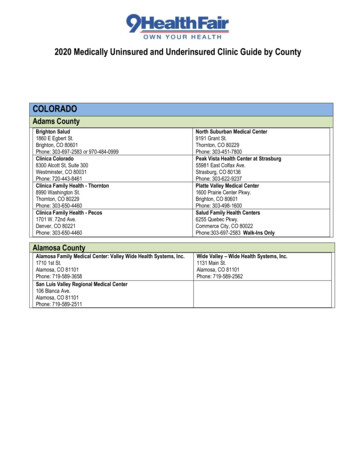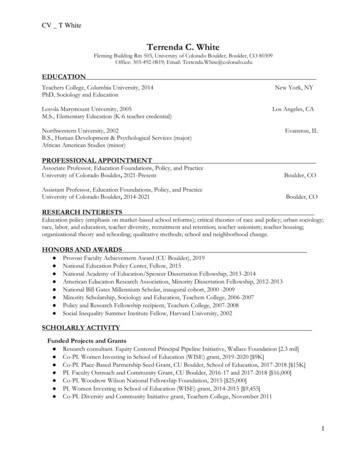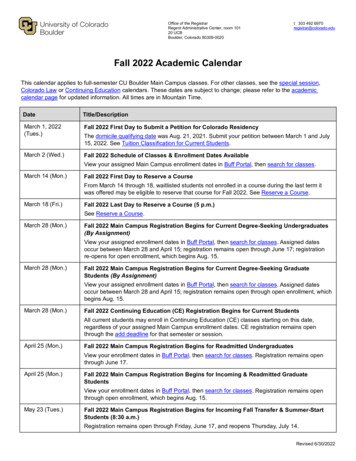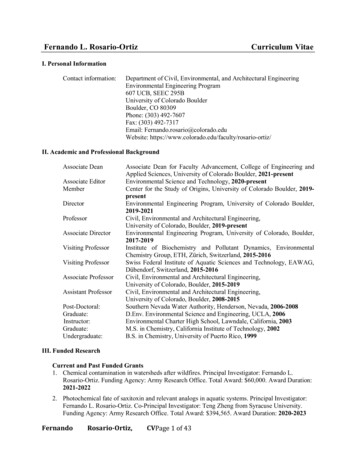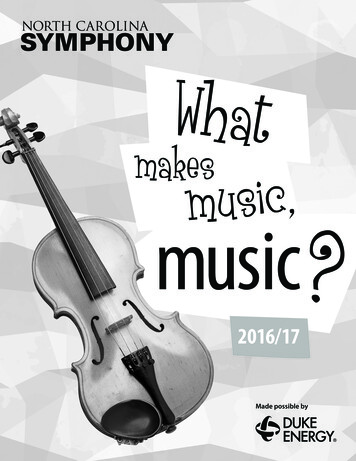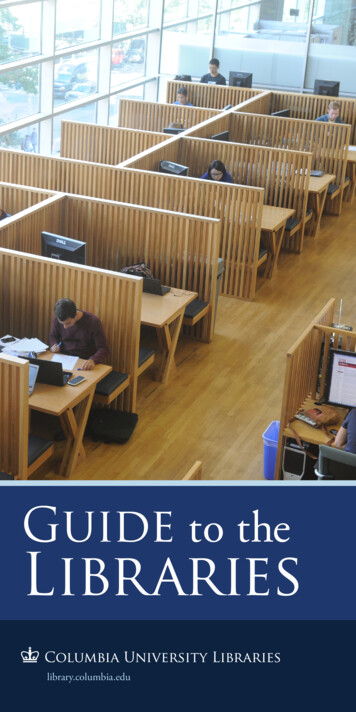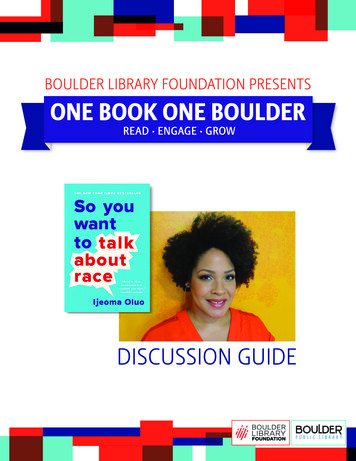
Transcription
BOULDER LIBRARY FOUNDATION PRESENTSONE BOOK ONE BOULDERREAD . ENGAGE . GROWBOULDER LIBRARY FOUNDATION PRESENTSONE BOOK, ONE BOULDER:A COMMUNITY READING PROGRAMSAVE THE DATEThursday, November 5th at Boulder Public LibraryJoin us for an evening with Ijeoma Olou, author of this year’sselected book, “So You Want to Talk About Race”For more information visit: boulderlibrary.org/one-bookDISCUSSION GUIDE
ABOUT THE AUTHORIjeoma Oluo is a Seattle-based writer and speaker. Named oneof the The Root’s 100 Most Influential African Americans in 2017,one of the Most Influential People in Seattle by Seattle Magazine,one of the 50 Most Influential Women in Seattle by Seattle Met,and winner of the of the 2018 Feminist Humanist Award by theAmerican Humanist Society, Oluo’s work focuses primarily on issuesof race and identity, feminism, social and mental health, socialjustice, the arts, and personal essay. Her writing has been featuredin The Washington Post and the Guardian, among other outlets.SUMMARYIn this New York Times bestseller, Ijeoma Oluo offers a hard-hitting but user-friendly examinationof race in America.Widespread reporting on aspects of white supremacy–from police brutality to the massincarceration of Black Americans–has put a media spotlight on racism in our society. Still, it is adifficult subject to talk about. How do you tell your roommate her jokes are racist? Why did yoursister-in-law take umbrage when you asked to touch her hair–and how do you make it right? Howdo you explain white privilege to your white, privileged friend?In “So You Want to Talk About Race”, Ijeoma Oluo guides readers of all races through subjectsranging from intersectionality and affirmative action to “model minorities” in an attempt to makethe seemingly impossible possible: honest conversations about race and racism, and how theyinfect almost every aspect of American life.Source: o-talk-about-race/9781580056779/
DISCUSSION GUIDELINES & QUESTIONSBASIC GUIDELINES1. If you are in a majority white space, talk with people of color in advance—in a private, safesetting—to hear their concerns about the upcoming discussion. Ask what subjects they areeager to discuss, and if there are subjects they do not want to discuss. Ask what would makethem feel safe and comfortable. Then, incorporate these needs and boundaries into theagreed-upon parameters of the discussion. Be prepared to enforce them instead of waitingon the few people of color in the group to risk ostracization by speaking out.2. Be aware of who in the group is given the most space to talk and try to center theconversation around voices of color—and in particular non-male voices of color.3. Ask all attendees what they hope to get out of the book, and out of the group discussion.Encourage group members to verbalize their intentions so that everyone has a better chanceof reaching aligned goals.4. Make space for the fear, anger, and hurt of people of color. Abuse is never okay, but what isoften called “abuse” in heated discussions on race is often simply people of color expressingvery justified emotions about living in a white supremacist society. It’s fine to maintain firmboundaries about what sort of language and behavior is and is not tolerated, but considerrereading the chapter on tone policing (chapter 15: “But What If I Hate Al Sharpton?”) beforeyou decide what language is acceptable.5. Do not allow racist statements or slurs against people of color. When people of color finallyfeel safe enough to honestly talk about their experiences, nothing hurts more than to beanswered with a racist reply. It is an act of violence against people of color and a betrayal ofthe group. Be very clear about this from the start and be prepared to remove offenders ifthey are making people of color feel unsafe.6. Try to tie the discussion to issues that are happening in your group’s community.7. Don’t be afraid to pause conversations that are becoming overly heated, or if you feel thatpeople of color in the group are not feeling safe.Continued on next page.
DISCUSSION GUIDELINES & QUESTIONSBASIC GUIDELINES8. Do not allow white group members to treat their discomfort as harm done to them.Remember, the primary focus of this book—and therefore, hopefully, your discussiongroup—is how we can talk about the systemic harm done to people of color by a whitesupremacist society. It is the instinct of our culture to center white emotions andexperiences; don’t let that happen in these discussions. The comfort of white attendeesshould be very, very far down on the priority list. If white attendees feel strongly that theyneed to center their feelings and experiences in the discussion, set up a space away fromthe group where they can talk with other white people. Do not let it take over the groupdiscussion or become a burden that people of color in the group have to bear.9. Don’t allow people of color to be turned into priests, therapists, or dictionaries for whitegroup members. If you are white, you shouldn’t be looking to the people of color inthe group to absolve you of your past sins, process your feelings of guilt, or help youunderstand every phrase in the book that gives you pause.10. Acknowledge that your discussion is a very, very small step in your efforts to tackle issueson race. Even if you are reading this book to help you process a specific issue affectingyour community, workplace, school, or organization, chances are that it will not be solvedin a few gatherings. This book is meant to help you have better conversations in the hopethat you will have many of them. Centuries-old constructs of race and generations ofsystems of oppression are not torn down in a few hours. Appreciate the small moments ofprogress as you make them—because every bit of progress matters—and also know thatyou will still have more to do. Do not allow yourself to become overly discouraged by thetask ahead of you.11. For people of color in the group: please know that you have every right to your boundaries,your feelings, your thoughts, and your humanity in this discussion. You have the right tobe heard, and your experiences are real and they matter. Please remember that. And thankyou—thank you for your generosity in joining yet another conversation on race. If you donot hear this from other members, please hear it from me. You are appreciated.
DISCUSSION GUIDELINES & QUESTIONSDISCUSSION QUESTIONS1. In chapter 1, “Is It Really About Race?,” the author states: “It is about race if a person of colorthinks it is about race. It is about race if it disproportionately or differently affects people of color.It is about race if it fits into a broader pattern of events that disproportionately or differently affectpeople of color.” After reading the author’s explanation of these points, can you think of social orpolitical issues that many people currently believe are not about race, but actually may be? Whichof the above guidelines for understanding when it is about race fit those issues?2. The chapter about privilege is placed right before the chapter on intersectionality. The authorhas stated in interviews that she placed those chapters in that order because it is impossible tofully understand intersectionality without first comprehending privilege. How do the conceptsdiscussed in the chapter “Why Am I Always Being Told to ‘Check My Privilege’?” help deepenyour understanding of intersectionality and help implement intersectionality into your life?3. The author states that she grew up in a majority white, liberal area and was raised by awhite mother. How might that upbringing have influenced the way that she wrote this book?How might it have influenced the personal events she describes in the book? How might thisbook have been different if written by a black person with a different upbringing, or if writtenby a person of color of a different race?4. Throughout the book, the author makes it clear that this book is written for both white peopleand people of color. But does the author expect white people and people of color to readand experience this book in the same way? What are some of the ways in which the authorindicates how she expects white people and people of color to react to and interact withportions of the book? What are some of the ways in which the author discusses the differentroles that white people and people of color will play in fighting systemic racism in our society?5. In chapter 12, “What Are Microaggressions?,” the author lists some of the racial microaggressionsthat her friends of color said that they often hear. What are some of the racial microaggressionsthat you have encountered or witnessed? What are some that you may have perpetrated on others?6. Chapter 15, “But What If I Hate Al Sharpton?,” discusses the issue of respectability politics andtone policing. What burdens of “respectability” and “tone” do you see placed on differentpopulations of color in our society?7. The final chapter, “Talking Is Great, but What Else Can I Do?,” discusses some actions you cantake to battle systemic racism using the knowledge you’ve gained from this book and fromyour conversations on race. What are some actions you can take in your community, yourschools, your workplace, and your local government? What are some local anti-racism efforts inyour community that you can join or support?Source: ress-ReadingGuide-So-You-Want-To.pdf
REVIEWSPublishers WeeklyOluo, an editor at large at the Establishment, assesses the racial landscape of contemporaryAmerica in thoughtful essays geared toward facilitating difficult conversations about race.Drawing on her perspective as a black woman raised by a white mother, she shows how raceis so interwoven into America’s social, political, and economic systems that it is hard for mostpeople, even Oluo’s well-intentioned mother, to see when they are being oblivious to racism.Oluo gives readers general advice for better dialogue, such as not getting defensive, statingtheir intentions, and staying on topic. She addresses a range of tough issues—police brutality,the n word, affirmative action, microaggressions—and offers ways to discuss them whileacknowledging that they’re a problem. For example, Oluo writes that the common phrase“check your privilege” is an ineffective weapon for winning an argument, as few people reallyunderstand the concept of privilege, which is integral to many of the issues of race in America.She concludes by urging people of all colors to fear unexamined racism, instead of fearing theperson “who brings that oppression to light.” She’s insightful and trenchant but not preachy,and her advice is valid. For some it may be eye-opening. It’s a topical book in a time whenracial tensions are on the rise.Library Journal/* Starred Review */ In her first book, writer and activist Oluo offers direct advice on howto have a conversation about race. She analyzes topics that may lead to contentiousconversations, such as cultural appropriation, affirmative action, police brutality, the N-word,microaggressions, and the model minority myth. In doing so, Oluo provides backgroundinformation on each topic and talking points to allow for having more constructiveconversations. With a clever approach that uses anecdotes, facts, and a little humor, the authorchallenges all readers to assess their own beliefs and perceptions while clearly looking atpolarizing issues. She encourages us to overcome the idea of debating someone else withoutthe ability to listen to other perspectives. Most relevant is a sobering and enlightening chapteron checking and recognizing one’s privilege. VERDICT A timely and engaging book that offersan entry point and a hopeful approach toward more productive dialog around tough topics.Highly recommended for those interested in race, ethnicity, and social commentary, andanyone wishing to have more insightful conversations.
REVIEWSKirkusStraight talk to blacks and whites about the realities of racism. In her feisty debut book,Oluo, essayist, blogger, and editor at large at the Establishment magazine, writes fromthe perspective of a black, queer, middle-class, college-educated woman living in a “whitesupremacist country.” The daughter of a white single mother, brought up in largely whiteSeattle, she sees race as “one of the most defining forces” in her life. Throughout the book,Oluo responds to questions that she has often been asked, and others that she wishes wereasked, about racism “in our workplace, our government, our homes, and ourselves.” “Is it reallyabout race?” she is asked by whites who insist that class is a greater source of oppression. “Ispolice brutality really about race?” “What is cultural appropriation?” and “What is the modelminority myth?” Her sharp, no-nonsense answers include talking points for both blacks andwhites. She explains, for example, “when somebody asks you to ‘check your privilege’ theyare asking you to pause and consider how the advantages you’ve had in life are contributingto your opinions and actions, and how the lack of disadvantages in certain areas is keepingyou from fully understanding the struggles others are facing.” She unpacks the complicatedterm “intersectionality”: the idea that social justice must consider “a myriad of identities—ourgender, class, race, sexuality, and so much more—that inform our experiences in life.” She askswhites to realize that when people of color talk about systemic racism, “they are opening up allof that pain and fear and anger to you “ and are asking that they be heard. After devoting mostof the book to talking, Oluo finishes with a chapter on action and its urgency. Action includespressing for reform in schools, unions, and local governments; boycotting businesses thatexploit people of color; contributing money to social justice organizations; and, most of all,voting for candidates who make “diversity, inclusion and racial justice a priority.” A clear andcandid contribution to an essential conversation.
IF YOU LIKE THIS BOOK, YOU MAY ENJOY:Alexander, Michelle. The New Jim Crow. A legal scholar argues that the War on Drugs andpolicies that deny convicted felons equal access to employment, housing, education, and publicbenefits create a permanent under caste based largely on race.Coates, Ta-Nehisi. Between the World and Me. Told through the author’s own evolvingunderstanding of the subject over the course of his life comes a bold and personal investigationinto America’s racial history and its contemporary echoes.DiAngelo, Robin. White Fragility. Like So You Want to Talk About Race, this concise andpersuasive primer for combating institutional racism provides readers with practical tools tounderstand and confront racial bias.Kendi, Ibram X. How to Be an Anti-Racist. Blending memoir and social commentary, this frankand insightful book discuss how individuals can combat systemic racism in thought and action.Khan-Cullors, Patrisse and and Asha Bandele. When They Call You a Terrorist: A Black LivesMatter Memoir. A memoir by the co-founder of the Black Lives Matter movement explainsthe movement’s position of love, humanity, and justice, challenging perspectives that havenegatively labeled the movement’s activists while calling for essential political changes.Annotations courtesy of NoveList Database, available at Boulder Library.
AUTHOR INTERVIEWIjeoma Oluo on the “perfect storm” that finally engaged white America on racism.By Emily Stewart June 9, 2020For much of America to wake up to the realities of systemic racism and police brutality, thecontext had to be extreme; the violence had to be prolonged — more than eight minutes of ablack man suffering, a knee on his neck, saying he can’t breathe. The cameras had to not only berolling, but the officer had to look directly at it without caring he was being filmed, or apparentlyworried that he was risking his own health in the middle of a pandemic. And an audience had tobe watching, pleading “to let him breathe.” All over a 20 bill.“Violent white supremacy doesn’t rest,” says Ijeoma Oluo, speaker and author of the bookSo You Want to Talk About Race.But for many white Americans, this idea of active white supremacy is not one they have everthought about before. Amid George Floyd’s death and the protests it has inspired over the pasttwo weeks, the country is waking up. The issues demonstrators are pushing against aren’t new— especially to black, brown, and indigenous people who have experienced them their entirelives. But the diverse and widespread outrage over them we’re seeing right now is. Polls showswift and significant shifts in attitudes about police violence toward people of color.The conversation about racism in America, especially for those new to it, is uneasy andimperfect. Oluo knows: She dedicates much of her time talking about how to talk about race,as the title of her book suggests.She and I recently spoke about her views on the current moment, the Black Lives Mattermovement, and what it will take to create lasting change. It’s not inevitable that the protestswill fade quickly — the Montgomery, Alabama, bus boycott lasted for 381 days — but it’s vitalto have conversations now while the energy is high about what happens next.We also talked about what it means to get educated on racism and to do the work and whatisn’t helpful when it comes to solidarity. For example, those black boxes on Instagram lastweek — not the best idea.“Be wary of anything that allows you to do something that isn’t actually felt by people ofcolor,” Oluo said. “I always ask myself when I’m trying to do solidarity work, can the peopleI’m in solidarity with actually feel this? Can they spend this? Can they eat this? Does thisactually help them in any way? And if it doesn’t, let it go.”
AUTHOR INTERVIEW CONT.And those looking to help need to focus on more than police brutality. Racism factors into somany parts of the cultural fabric — education, work, housing, and much more. That requiresattention, too. “It’s not just that we deserve to not be killed,” Oluo said. “We deserve to thrive inthis country, just like everyone else.”Our conversation, lightly edited for length and clarity, is below.Emily StewartJust to start off, how are you feeling in this moment?Ijeoma OluoI’m exhausted, honestly. It’s been a lot, and I’m preparing to do more. I think that right now weare tired and scared and sad and a little excited to see some steps toward real change, and I’mkind of holding all of that in me right now. But mostly, I’m very, very exhausted.Emily StewartIs this a moment in your mind? Is this something different that’s happening right now?Ijeoma OluoI would say it’s definitely a moment that we have not seen in at least 30 years, as far as anationwide movement for change, where we’re actually starting to see some cities payingattention and seeing a shift in the national conversation about racism, systemic racism, andpolice brutality in America. What will come? I don’t know if it will lead to something differentthan what we’ve seen, but it is different this time.Emily StewartWhat’s different?Ijeoma OluoRight now, it’s really been a perfect storm. We haven’t seen protests in all 50 states where youcould have a day where every state, and then multiple countries around the world, are joining in tosay that black lives matter, to say that enough is enough. We haven’t seen that in a very long time.What’s happening right now — when you have people who are already tired and scaredand worried about the pandemic that we’ve been in — is that not only did it hit the blackcommunity especially hard to see that violence in the midst of this pandemic that’s coming forus, but to also see that violent white supremacy doesn’t rest. Police will still take the time andrisk their own health to take the life of a black person.
AUTHOR INTERVIEW CONT.Ijeoma OluoIt also shocked the rest of the country to realize this is how ingrained it is. It is this ingrained,when everyone is supposed to be staying home, when we should all have bigger things to worryabout, that a supposedly fraudulent 20 bill will cost a black person their life.I think that we were all feeling raw. We all had less reserves, and it was just a collective“enough.” It’s been enough for a lot of us for a very long time, but I’m still glad to see so manypeople coming out in solidarity.Emily StewartHow is the conversation about race different from in the past? Ten years, five years, even twoyears ago?Ijeoma OluoWhen I started writing, “Black Lives Matter” wasn’t a phrase that was even said. I rememberdesperately getting people to just recognize why they should care about this. And Black LivesMatter itself was a movement just trying to say that we deserve to live. And a large segmentof the American population that was still struggling with, “Is Black Lives Matter the thing tosay?” have set that aside now. They’re saying okay, there is a problem, we’re not going to arguewhether this is something we should be saying. We’re moving past that. And that is new. Thereare, of course, still some people who love to shout, “All lives matter.” But I used to run into wellmeaning people asking, why do I have to say this? They’re not asking that question anymore.That’s new, because it allows us to start talking strategy.When I wrote my book, I remember talking in a chapter about police brutality and reform.My book is kind of an introduction to race, and I am so encouraged to see people move so farpast that to be talking about what it means to defund, to completely restructure how we keepcommunities safe and healthy. I love seeing people who maybe a year ago thought reform wasthe way to go now saying, wait a minute, what if we imagine a whole system that doesn’t relyon criminalization, that doesn’t have a certain amount of brutality built into it as the thing weput up with to feel safe?That is what is encouraging to me, seeing people move past, “Is this a big deal?” to “What is thebest way to tackle it?”
AUTHOR INTERVIEW CONT.Emily StewartA lot of white people seem to have been caught by surprise by the realities of police brutalityand racism. Why do you think that is?Ijeoma OluoOur culture still frames racism as something that lies fully within the hearts and minds of racistwhite people. It’s racism if you hate, and therefore if we can just find the few people who hatepeople of color, who hate black people, then we could solve racism if we could just solve them.What that means is that the everyday fear and heartbreak and stigmatization that we deal within this country is largely ignored.You don’t see after-school specials on racism that talk about the ways in which teachers don’tthink you wrote your paper because you did really well on it, or how people with their hair inbraids are seen as less professional. These are not issues that people think of when they thinkracism. When I give talks, when I say someone’s a racist, what do you think? And people say,“The Klan.”For people to realize that it had to be so bad in our police forces, it wasn’t just the act. It wasn’tjust the fact that the way George Floyd was killed was so shocking. It was the fact that thingshad to be so bad that all four of those officers knew that they would be completely fine tomurder someone long and painfully in front of cameras, in front of a live audience. What itspoke to was not just those officers, it spoke to an entire culture. You can’t say it’s a few badapples at that point. That’s where a lot of that shock is coming from.It’s frustrating. I know that I’m frustrated, and I’m hearing from so many other black people whoare so frustrated at getting phone calls from white people they’ve known for a long time sayingthey had no idea. And you think, “Why weren’t you listening to me? I’ve been saying this thewhole time. I’m a human being with words who can say that this is what’s happening.”Had it just been one officer, it wouldn’t have been as shocking. But to see four officers participatein this, in front of an audience, knowing they were being recorded, was really what showed thatthis goes deep. This is a systemic issue in a way that people who don’t have to worry about thesystem of policing had [not seen].
AUTHOR INTERVIEW CONT.Emily StewartSo when we see white people rallying en masse against racism now and in support of BlackLives Matter, do you think it really is just seeing George Floyd’s murder? Or what do you think ishappening, that these protests are now finally very diverse?Ijeoma OluoI think that’s part of it. It really did shock the conscience of people in ways it hasn’t before.It’s important to note for the black community, for the indigenous community, it was not justGeorge Floyd. It was the accumulation of Breonna Taylor and all these other beautiful black andindigenous lives that have been taken.It’s also white people are seeing other people say something, speaking out, protesting. Andthey’re saying, “I can do it, too.” And it’s contagious. People forget that this sort of resistanceis a social activity — it’s not a fun social activity, but it is a social activity. It is a collectivemovement, and it does cause more people to come out.I do think people have more time. We can’t overestimate the impact of a lot of people being outof work, having time to get out there with protests and talk about this.Our social connections to people via the internet are sustaining us in a way that hasn’thappened in the past, because we can’t see people in person. Therefore, we’re talking aboutthese things in a way that we weren’t before. We’re not going out to a bar; we’re talking aboutthe social issues of the day on social media. And I think that’s also contributing to it. I hateto use the phrase perfect storm, but it took a perfect storm of events to really engage whiteAmerica in a way that hasn’t happened before.
AUTHOR INTERVIEW CONT.Emily StewartSo what is your advice to those white people who want to talk about race right now?Ijeoma OluoRight now, you need to be running two tracks at the same time.You have to be running your track of education, asking why didn’t I know about this? Whywasn’t I doing something sooner? Where am I lacking? What words are confusing me? Startreading up and start learning.At the same time, look at being of use. Look at what your local protest leaders and resistanceleaders are doing. Do they need donations? Do they need masks? Do people need certainmessages amplified? Start looking at conversations you can be having in your cities, your towns,your school districts, in your offices to bring those issues forward.It’s not just that we deserve to not be killed. We deserve to thrive in this country, just likeeveryone else.Look how you can be of use to the people who have been struggling for justice and for black,indigenous, and people of color to really thrive in this country. Ask how you can help makesure that it’s something people actually want and can feel.It’s not just money, but if you can, give money to causes. But give your time. Amplify voices.Open doors. If someone’s saying they’re having trouble at your office talking about the issueof race, can you add your voice to back that person up? If your school board is not talkingabout the ways in which their disciplinary systems are set up, or talking about getting policeout of schools, that is something that you can bring up. And you can bring your friends in.Start looking at how you can be of use, and then also, at the same time, keep your personaleducation going.
AUTHOR INTERVIEW CONT.Emily StewartWhat should people avoid when talking about race?Ijeoma OluoIf you are a white person, right now is not the time to go seek out the most racist person andtry to tell them they’re an awful person and argue with them — not because they don’t needto know that, because I think that open racism should always be met with resistance andpushback, but because our time is precious and you need to be doing actions.There’s something really performative about saying, “I spent all my day today arguing with myTrump-loving uncle.” I, as a black person, don’t know your Trump-loving uncle. I don’t feel that— the only reason why I know is because you posted that you did it. It does not help my life.I hear from a lot of people saying, “I’ve never been black, but this happened to me, so I knowwhat it’s like.” Don’t minimize the experiences of black and indigenous people with stateviolence by comparing it to the time that someone didn’t like you or you were accused of doingsomething you didn’t do. Recognize that you will never fully know what it’s like to live underwhite supremacy as a black and indigenous person in this country. You will just have to believeus, and you just have to take us at our word and fight with us. Don’t try to make it about you.Don’t try to make it about your pain and your journey, and keep your energies focused onwhere you can be of use to the struggle and to the movement that’s happening right now.
AUTHOR INTERVIEW CONT.Emily StewartWhen you talk about the question of being performative on social media, I’m curious aboutyour thoughts on Blackout Tuesday, when people were posting black boxes on social media toshow solidarity. Is that helpful?Ijeoma OluoIt’s not helpful; it actually harms things. And I think it’s an important conversation to have.This is very similar to me to the whole safety pin debacle after Trump’s election [where peopleput a safety pin on their clothes to signify they opposed acts of religious and racist violence andabuse in the wake of his victory]. What it is is people who are looking for something quick thatthey can do to feel like they’ve done something.These are not things that black people come up with. When I’m thinking, what would help mefeel safe in this country? It’s not “I wish everyone’s Instagram squares were black.” I can’t feelthat. Especially when cou
ONE BOOK ONE BOULDER READ . ENGAGE . GROW DISCUSSION GUIDE BOULDER LIBRARY FOUNDATION PRESENTS ONE BOOK, ONE BOULDER: A COMMUNITY READING PROGRAM SAVE THE DATE Thursday, November 5th at Boulder Public Library Join us for an evening with Ijeoma Olou, author of this year's selected book, "So You Want to Talk About Race"
